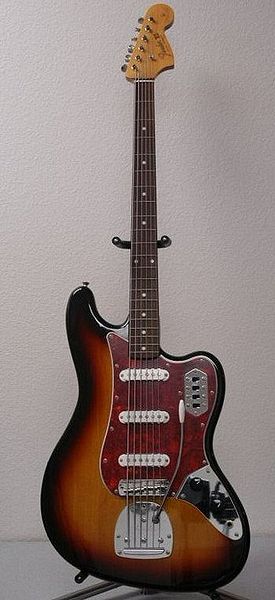Fender VI
| Fender VI | |
|---|---|
 |
|
| General | |
| Type | Electric bass ( baritone guitar ) |
| Manufacturer | Fender ; USA , Japan , China |
| production | 1961–1975, since 2013 |
| Construction and materials | |
| Scale length | 30 inches (762 mm) |
| Body | Solid body made of alder |
| neck | Screwed maple neck |
| Fingerboard | Rosewood , 21 or 22 frets |
| saddle | Synthetic bone , width: 42 mm |
| Mechanics | 6 × left; capsuled |
| Footbridge / bridge | " Fender Vibrato " with individual saddles |
| Pickups and Electronics | |
| Pickups |
|
| Tone control | passive
|
| Unless otherwise stated, the data come from the manufacturer's website (as of June 9, 2014) | |
The Fender VI is a six-string electric bass model from the US musical instrument manufacturer Fender . The model was added to the product range in 1961 and went down in history as the Fender VI or "Jaguar Bass" (because of its visual similarity to the Fender Jaguar electric guitar model ). The Fender VI is tuned an octave lower than a guitar (sometimes also like a baritone guitar ) and has a relatively narrow neck that is only slightly longer than that of an electric guitar. This should make it easier for guitarists to switch to bass. The Fender VI was not developed to compete with the bass classics Fender Precision Bass and Fender Jazz Bass , but was based on the then only six-string electric bass model from the manufacturer Danelectro and was intended to secure corresponding market shares for Fender.
construction
The bass has 22 frets , three pickups in a single coil design ( single coil ), a vibrato lever and an asymmetrical body . The Fender VI differs significantly from the concept of the bass classics Fender Precision Bass and Fender Jazz Bass in that it has six instead of four strings, a smaller string spacing, a shorter scale length, three separately controllable pickups, and a vibrato lever. The Fender VI, which is designed as a lead instrument , differs from the classics Precision and Jazz Bass in terms of sound. Due to the low demand and the relatively high purchase price, production was discontinued in 1977 after only 800 copies had been built, which is why examples from the original production of those years are now highly sought-after objects. In 1995 a reissue model was released according to the specifications of 1962 from Japanese production, but with a slightly longer scale length (30.3 inches).
In 2013 Fender reissued the instrument as Bass VI in a modernized version as part of the Pawn Shop series; The special features here are a humbucker in P-90 optics as a bridge pickup , a five-way selector switch instead of individual switches for each pickup and the elimination of the chrome cover for the electronics compartment, which is now also covered by the pickguard.
Well-known Fender VI players
The most famous group that used a Fender VI were the Beatles . They purchased the instrument in 1968. It was used by guitarists John Lennon and George Harrison when Beatles bassist Paul McCartney played guitar or keyboard . The bass can be heard on a number of tracks on the so-called " White Album ". George Harrison also plays him in the promotional film for the song Hey Jude .
The English instrumental band Shadows with their solo guitarist Hank Marvin used the Fender VI for the pieces Stingray, Alice in Sunderland and Late Night Set . Curiously, the Fender VI didn't function as a bass guitar, but as a melody instrument. Another musician who used the Fender VI was Roy Babbington ( Soft Machine ). Jack Bruce also played a bass VI in his early days with Cream in the mid-1960s (heard on the band's first album, Fresh Cream ).
Jet Harris (ex-member of the Shadows) used the bass for the first time as a solo guitar in 1962. He had a No. 1 hit in England in 1963 with the piece Diamonds . From 1975 Henk Bruysten ( Hank the Knife and the Jets ) started using the Fender VI. The instrument dominated the band's biggest hit, Guitar King . Inspired by this title, Chris Mike ("Thunder - the Legend") also uses the bass as a solo instrument because of its " twang " sound.
In the mid-1970s, the Bass VI fell into oblivion, until Robert Smith used it again intensively on The Cure - to be heard in the songs Faith, Pictures of You and Lullaby, among others .
The bassist of the band Blink-182 , Mark Hoppus , used this bass on some gigs for the song I Miss You . This bass can also be heard on the song All of This (on the Untitled album ), which Blink-182 recorded with Robert Smith.
Individual evidence
- ↑ a b c d The Fender Bass VI on the page of The Band (English)
- ↑ a b c The history of the Fender VI on musicradar.com (English)
- ↑ fender.com ( Memento of the original from June 15, 2013 in the Internet Archive ) Info: The archive link was inserted automatically and has not yet been checked. Please check the original and archive link according to the instructions and then remove this notice.